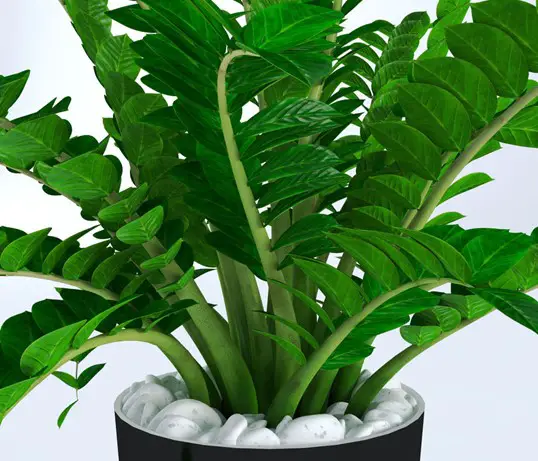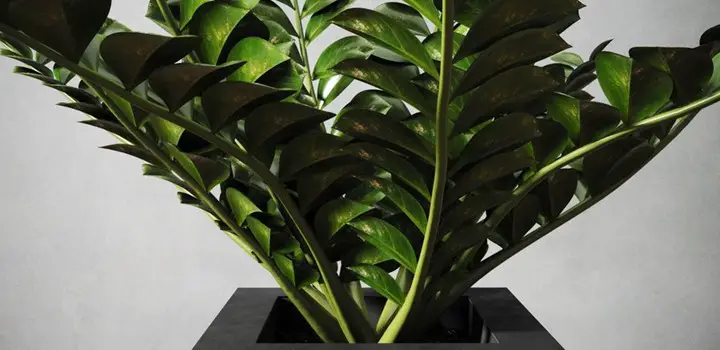ZZ plants are one of the most preferable houseplants. Being native to Eastern Africa this plant has different issues in adapting to other regions.
Mostly due to slow growth and dormancy growers suffer a lot with this plant. You may have also noticed the same in your ZZs. Restricted growth, leggy appearance, and lower new leaf productions are the common concerns.
Before diving in, let’s check, what are we going to look into today.
unfavorable weather and stress conditions like low light and humidity, nutrient deficiencies, pests, and diseases are the causes of the ZZ Plant not Growing.
Well, there’s nothing to worry about! You can easily deal with these with proper strategies. Here I have come up with some tips and tricks marking the most common growth issues which will be helpful for you.
So, let’s start without any further ado.
Why Has My ZZ Plant Stopped Growing [Causes & Controls]

Among different houseplants, ZZ plants are quite slow-growing. Moreover, October to February is the dormancy period for them. So in this period, you may notice a slower growth rate. It’s not that serious actually as this is their normal physiology.
In general, a growth pattern of 15-20 cm each month is considered to be normal.
But if it tends to show restricted growth for a longer period even after dormancy, you may need to put a closer look at your plants. Here are the causes.
1. Low Light & Temperature
Light, temperature, humidity, and other surroundings affect plant overall growth a lot. Houseplants are mostly affected by different environmental conditions. ZZ plants are also susceptible to these.
If your ZZ plant is not growing straight and has a leggy structure, this may be because of prolonged low light. Sometimes plants can grow tall without any firm structure. Outward growth can also be seen in some cases. Low light issues also discourage new leaf growth.
Let’s check what you can do in such a case.
Control Measure
It’s not possible to alter the climate, but some measures can help you in getting better results with ZZ plant growth.
For light and temperature, place your plant in a full sun condition for some time. But avoid scorching radiation. You may place them beside your window, this will provide moderate light and temperature to your ZZs.
Beware of cold drafts in your region; you may need to warm up your room at night to prevent such climatic conditions. Room heaters can be used in such cases.
2. Low Humidity
ZZ plants are quite sensitive to low humidity. As natural humidity levels vary from region to region, it’s important to keep checking this attribute.
Mostly light and humidity affect the growth the most. Placing ZZ plants in a low humid condition for a long time can restrict physical metabolic processes, thus hampering slow or no growth.
So, let’s take a look at how you can combat this.
Control Measure
Most of the houseplants need a humidity level of 50-60%. I know, it’s a bit tough to maintain, especially in winter. So you can take the help of a humidifier to determine the room humidity first(our pick: AquaOasis Cool Mist Humidifier). Normally in winter ZZ plants can even survive in 30-40% humidity.
If the level drops, even more, misting some water around your plant can lift up the humidity to a moderate range.
3. Stress Condition
Adverse weather conditions can put plants under physiological stress. But don’t mix up these two issues. It’s easy to protect houseplants from different climatic conditions as you can move them here and there. However, if your plant is in a stress condition, it’s a bit tricky to handle.
Wilting leaves and retarded growth is a common sign that your plant is in stress condition. If you notice these, think about what you need to bring the change in.
Here are some of my suggestions on how you can save your stressed ZZ and boost up growth.
Control Measure
In case of heat stress, first of all, place your plant in a shady condition. Then water your plant and let it recover for some time. In this period you need to give your ZZs a break from fertilizers.
You can also use a growth enhancer. These are easily available. Here is my recommendation- Botanicare Liquid Karma Plant Growth Enhancer
But remember; do not apply any hormones when your plant is recovering. Wait for a week or two before such treatment.
4. Nutrient Deficiency
Nutrient deficiency can be marked as the main and most prominent reason behind the slow growth of the ZZ plant. Restricted growth, yellow and brown leaves are the main symptoms of nutrient deficiency.
Keep checking if your ZZ plant is showing these signs. If you notice any of them try to remember when you have last applied any supplement to your plant.
Not to be worried much, here I have some suggestions for you.
Control Measure
Remember, ZZ plants uptake nutrients mostly from the surrounding soils. So it’s important to have better soil near the base.
In such a case, try to add some good fertilizers to your pot. A balanced fertilizer can help you to invest less time on different nutrient issues. Generally, I can suggest to you an NPK containing one which is a brilliant option for houseplants (our pick: Aquatic Arts Indoor Plant Food).
Nutrients can be leached out more often with watering, which can also pull off the basic soil nutrients too. So, you can practice repotting your plant in a fresh soil medium for better growth.
5. Pests & Diseases
Pests are the most annoying issue for houseplants. They interfere with plant growth by hampering genetic potentiality. The situation is worse when this is associated with fungi and other diseases.
If your plant is affected by pests, it will show stunted growth. They can eventually kill the plant too. So it’s important to check for pest attacks in your ZZ plant.
Aphids, mites, whiteflies, scale insects are common pests in the ZZ plant. You can observe the leaves to detect their presence. Even some symptoms like brown or yellow spots can tell you that bugs are there.
These pests cause fungal growth. So, don’t forget to look for symptoms of yellow or brown leaves which can be the reason behind stunted growth in your plant.
Control Measure
First, splash your plant with a good flow of water to remove pests. Then you can start treating.
For treatments, choose some low-dose pesticides containing horticultural oils. These are comparatively safer for houseplants (our pick: Bonide (BND951) – Systemic House Plant Insect Control).
To control fungal infection use a commercially formulated fungicide(Our Pick: Bonide Copper Fungicide). Don’t overwater your plant as excessive moisture promotes such issues.
Last but not the least, trim off infected leaf portions to discourage any fungal growth.
Home Remedies
#Recipe 1: Chili Spray
Ingredients:
- 1.5 tablespoons of chili powder
- 2 to 3 drops of liquid soap
- 1 liter of water
Steps:
- Mix chili powder with water and keep this solution for at least 12 hours
- Strain the solution and use the liquid to your plant to minimize pest attacks
#Recipe 1: Baking Soda Solution
Ingredients:
- 2.5 teaspoons of baking soda.
- 5 to 6 drops of liquid soap
- 2.5 liters of water.
Steps:
- Add baking soda and mix some liquid soap into it.
- Transfer this into a spray bottle and apply it to the ZZ plant
Here’s a bonus tip – You can use sticky tapes to control pest attacks in the future. Just place them somewhere near your ZZ plant.
Well, I have almost ended up discussing most of the vital reasons behind slow growth in the ZZ plant. Now let’s come to some frequently asked questions that may also be your query. So, keep reading.
FAQs
How to grow the ZZ plant faster?
As I have already mentioned that ZZ plants are slow growers, apart from the dormancy period some tricks may help you to improve their growth.
Well, you can’t trim their stems to make a bushier appearance like other plants. So what to do? Let me share good practice; divide your ZZs while repotting. It’s an easy task. Just break the rhizomes to separate different individuals.
This will encourage faster growth as there are more rhizomes to support each stem.
You will be surprised to know that some liquids lying in your kitchen can lift up the growth rate of your shiny ZZs. Soaked tea and coffee groundwater can help in this case by providing nitrogen to the soil. You can also purchase some growth hormones formulated for houseplants.
When to water ZZ plants for better growth?
It’s a common query from readers as most of them end up overwatering ZZ plants. Actually, there is no hard and fast rule for watering. Once a month is enough.
Let me share from my experience here, the one I follow. As you know that it’s advised to fully dry up the soil before a good watering, wait for a bit here. Just lift up the pot to check whether it feels lighter. If so, then you can put water in it. This works nicely for me.
What liquid can make the ZZ plant grow faster?
Carbonated water contains CO2 which promotes plant growth. So, you can put some in your plant to see the change.
Conclusion
In this article, I have tried to discuss the major reasons behind retarded growth in the ZZ plant. It’s not that hard right?
Just pay a bit extra attention to the surroundings and note what your plant likes to have. Place it in a better place and provide proper water and nutrients. Follow my tips for boosting up overall growth.
It’s your turn now to deal with the issues. So, what are you waiting for? Start marking the lacking and adopt measures according to your need. Hope soon you will be happy with the results.
Don’t forget to share your ideas and problems with us. Our comment section is open for you as always.
Read More
